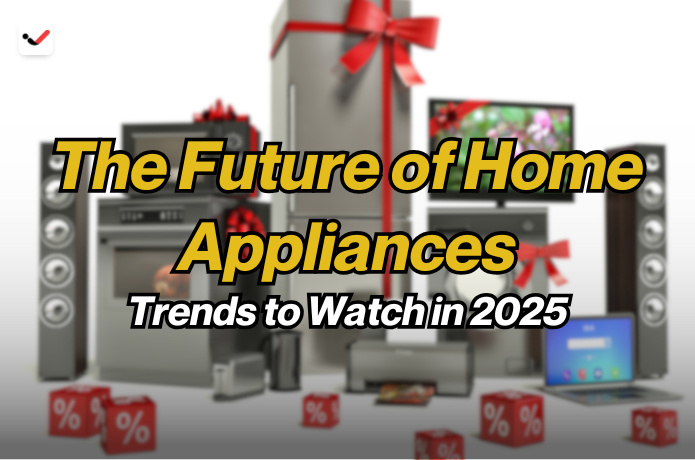The Future of Home Appliances: Trends to Watch in 2025
The Future of Home Appliances: Trends to Watch in 2025

Home appliances are evolving rapidly, making daily tasks easier and more efficient. With advancements in smart technology, artificial intelligence, and sustainability, the way people interact with their household devices is transforming. As 2025 approaches, new trends are emerging that will redefine convenience, energy efficiency, and automation in modern homes.
Consumers are now seeking innovative home appliances that enhance comfort, save time, and reduce environmental impact. Manufacturers are responding by integrating cutting-edge features such as voice control, smart sensors, and energy-saving technology. The coming year promises a wave of intelligent appliances designed to improve lifestyle and home management.
1. Smart and Connected Appliances
The rise of the Internet of Things (IoT) is making smart appliances more accessible and functional. Devices like refrigerators, washing machines, and ovens can now be connected to Wi-Fi, allowing users to control them through smartphones or voice assistants. Smart home integration enables seamless automation, providing real-time updates, maintenance alerts, and remote access.
Manufacturers are focusing on developing appliances that communicate with each other for improved efficiency. For instance, a smart refrigerator can suggest recipes based on its contents, while a connected oven can set the perfect temperature automatically. These advancements create a more intuitive and convenient kitchen experience.
2. Energy Efficiency and Sustainability
Energy-efficient appliances are gaining popularity as people become more environmentally conscious. Homeowners are looking for products that consume less electricity and reduce utility bills. Governments and organizations are also encouraging sustainable practices by offering incentives for energy-saving appliances.
In 2025, more appliances will feature eco-friendly materials, advanced insulation, and low-energy consumption modes. Solar-powered and water-efficient appliances are expected to become mainstream, helping households contribute to a greener planet while saving money in the long run.
3. Artificial Intelligence in Home Appliances
Artificial intelligence (AI) is transforming home appliances, making them smarter and more responsive. AI-driven devices learn from user habits and adjust their functions accordingly. For example, AI-powered washing machines can detect fabric types and automatically adjust water levels and washing cycles for optimal cleaning.
Voice recognition and machine learning are also enhancing user experience. Smart assistants integrated into appliances enable voice commands for hands-free operation. This technology reduces manual effort, making everyday tasks more convenient and efficient.
4. Touchless and Hygiene-Focused Appliances
The demand for hygiene-focused appliances has increased, leading to the development of touchless technology. Smart faucets, motion-sensor trash cans, and automatic soap dispensers are becoming essential in modern homes. These appliances reduce the spread of germs and enhance overall hygiene.
Self-cleaning and antimicrobial surfaces are also gaining traction. Refrigerators with built-in UV light sanitation and dishwashers with high-temperature steam cycles ensure a cleaner and safer home environment. The emphasis on hygiene will continue shaping the future of household appliances.
5. Multifunctional and Space-Saving Designs
As urban living spaces become smaller, homeowners are looking for compact, multifunctional appliances. Manufacturers are developing products that serve multiple purposes without compromising performance. For instance, washer-dryer combos and convertible refrigerators maximize space while maintaining efficiency.
Modular kitchen appliances that can be customized based on user preferences are also trending. These appliances adapt to different needs, making them ideal for modern homes where flexibility and space optimization are crucial.
6. Voice and Gesture Control Features
Voice and gesture control are becoming standard features in home appliances. Users can operate devices using simple hand movements or voice commands, reducing the need for physical interaction. This technology enhances accessibility, particularly for people with mobility challenges.
Smart TVs, air conditioners, and lighting systems are integrating gesture and voice recognition for a seamless user experience. These features make home automation more intuitive and user-friendly, simplifying daily tasks and improving convenience.
7. Faster and Smarter Cooking Appliances
Cooking appliances are advancing to make meal preparation quicker and easier. Smart ovens with built-in AI can recognize food items and automatically adjust cooking settings for perfect results. Induction cooktops with precise temperature control ensure energy efficiency and safety.
Instant cookers and air fryers with IoT connectivity are becoming household staples. These appliances allow users to monitor cooking progress from their smartphones, making home-cooked meals more convenient and efficient.
8. Enhanced Home Security Through Smart Appliances
Home security is becoming a top priority, leading to the integration of security features in home appliances. Smart doorbells, surveillance cameras, and AI-powered locks provide real-time monitoring and remote access. These appliances enhance safety, giving homeowners peace of mind.
Refrigerators, washing machines, and other household appliances are also incorporating security measures. Some smart refrigerators come with internal cameras that allow users to check their contents remotely, while smart locks on appliances prevent unauthorized access.
9. Subscription-Based Appliance Services
Subscription-based models are changing the way people use home appliances. Instead of purchasing expensive devices, users can subscribe to appliance services that provide regular upgrades and maintenance. This model ensures access to the latest technology without the burden of ownership costs.
Brands are introducing leasing options for high-end appliances, making them more affordable. These services also include automatic software updates and repair coverage, ensuring long-term functionality and convenience.
10. Personalization and Customization
Consumers are looking for appliances that cater to their unique needs. Customizable settings, personalized alerts, and adaptive functions allow users to tailor appliances to their preferences. Smart refrigerators can create shopping lists based on dietary habits, while AI-powered coffee makers can remember user preferences for the perfect cup of coffee every time.
Brands are also offering aesthetic customization, allowing homeowners to choose colors, materials, and finishes that match their interior decor. Personalization is becoming a key factor in appliance selection, making technology more user-centric.
The future of home appliances in 2025 is focused on innovation, efficiency, and convenience. With the rise of smart technology, AI-driven functionality, and sustainable designs, appliances are becoming more intelligent and environmentally friendly. These trends are shaping the modern home, making everyday tasks easier, safer, and more efficient.
As consumers continue to demand advanced features and energy-saving solutions, manufacturers are investing in technology that enhances user experience and home management. The coming year will bring exciting advancements, redefining how people interact with their household appliances.

